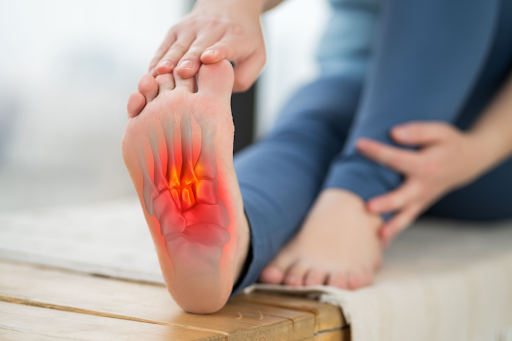What is Planter Fasciitis & How Do I Treat It?
Plantar fasciitis is a condition that brings frustrating heel pain, often striking when you take your first steps in the morning. That sharp, stabbing pain comes from inflammation in the thick band of tissue called the plantar fascia, which runs along the bottom of your foot. Plantar fasciitis pain can make everyday activities like walking, standing, or even wearing shoes a real challenge if left untreated.
Whether you’re dealing with a mild case or more severe symptoms of plantar fasciitis, there are effective treatments to help you recover. From nonsurgical treatments to physical therapy, options like stretching exercises, wearing supportive shoes, and even specialized ice treatments can go a long way toward alleviating pain. Let’s explore the causes, symptoms, and the best ways to treat plantar fasciitis so you can get back on your feet.
What Is Plantar Fasciitis?
Plantar fasciitis occurs when the plantar fascia, the band of tissue that runs from your heel bone to your toes, becomes inflamed. This thick band of tissue plays a crucial role in supporting the arch of your foot with every step. Tiny tears can form when too much stress is placed on it, causing inflammation and pain. It’s common to experience plantar fasciitis when the heel strikes the ground, leading to stabbing pain. Flat feet, tight calf muscles, and worn-out shoes are a few risk factors that contribute to plantar fasciitis pain. The condition can affect anyone, but it’s particularly common among runners, people with jobs that require standing for long periods, and those wearing old athletic shoes. But don’t worry — plantar fasciitis can be treated, and you can recover with the right steps.
Most Common Causes
Plantar fasciitis often develops when the thick band of tissue, known as the plantar fascia, is overworked or strained, leading to tiny tears and inflammation. This condition is especially common among individuals who put significant pressure on their feet due to certain lifestyle factors, physical activities, or even the structure of the foot itself. The repetitive stress on the plantar fascia can lead to persistent heel pain, particularly where the heel bone connects to the bottom of your foot. Below are the most common causes that increase your risk of experiencing plantar fasciitis:
- Tight calf muscles: Limited flexibility in your calf muscles can increase the strain on your plantar fascia, leading to plantar fasciitis symptoms.
- Flat feet or high arches: Both foot structures can alter how your weight is distributed, placing extra stress on the plantar fascia.
- Wearing old athletic or unsupportive shoes: Lack of proper arch support or cushioning from worn-out shoes can aggravate the plantar fascia and cause plantar fasciitis foot and chronic pain.
- Excessive physical activity: High-impact activities like running or jumping increase the likelihood of tiny tears in the plantar fascia, leading to tight muscles, pain, and inflammation.
- Prolonged standing or walking: Jobs or activities that require you to stand for long hours can put continuous pressure on the plantar fascia, causing foot pain.
Understanding these risk factors can help you prevent plantar fasciitis, Achilles tendon issues, heel spurs, and more by making small adjustments, such as wearing supportive shoes or incorporating stretching exercises into your routine.
How to Spot Plantar Fasciitis
Spotting the signs of plantar fasciitis early can help you manage the condition before it worsens. The most common symptom of plantar fasciitis is a stabbing pain at the bottom of your foot, usually around the heel bone, which is often worse with your first steps in the morning. As you move throughout the day, this heel pain may lessen but can flare up after long periods of standing, walking, or physical activity. Plantar fasciitis pain is caused by inflammation in the plantar fascia, a thick band of tissue that runs from your heel to your toes. Below are key signs and symptoms that indicate you may be dealing with plantar fasciitis:
- Stabbing pain near the heel: This is especially noticeable when taking your first steps in the morning or after sitting for extended periods.
- Heel or foot pain after activity: The pain may return after long periods of standing, walking, or physical exertion.
- Tenderness in the heel: Pressing on the area where the heel bone connects to the arch of the foot may reveal tenderness or discomfort.
- Tight calf muscles: Reduced flexibility in your calf muscles may worsen plantar fasciitis symptoms by pulling on the plantar fascia.
- Difficulty flexing the foot: You may experience stiffness or limited movement when stretching or flexing the affected foot.
Recognizing and addressing these symptoms early with appropriate treatment, like stretching exercises or wearing supportive shoes, can help reduce pain and promote healing.
The Best Treatment Options for Plantar Fasciitis
When it comes to treating plantar fasciitis, several nonsurgical treatments are available that focus on relieving pain and promoting healing. Stretching exercises can make a big difference, particularly those targeting the plantar fascia and calf muscles. A physical therapy program may include stretching routines designed to lengthen the plantar fascia and reduce heel pain. Night splints and soft silicone heel pads can also help relieve pain by keeping the affected foot in a neutral position while you sleep. Wearing supportive shoes or shoe inserts with proper arch support can prevent further strain on your plantar fascia and promote healing.
In some cases, nonsteroidal anti-inflammatory drugs (NSAIDs) can help decrease inflammation. For those who need additional relief, treatments like extracorporeal shockwave therapy or even a partial plantar fascia release may be recommended. Exploring all these options is essential to ensure you’re giving your foot the best chance to recover.
Choose the One Oak Medical Team for Your Plantar Fasciitis Treatment Needs
At One Oak Medical, we take your heel pain seriously and are committed to providing personalized care for plantar fasciitis throughout North Jersey. Whether you’re experiencing mild discomfort or severe pain, our team will guide you through various treatment options designed to effectively treat plantar fasciitis. We focus on treatments that alleviate pain and promote long-term healing. From stretching exercises to advanced nonsurgical treatments, we have the tools and expertise to help you recover and reduce heel pain.
We’ll work with you every step of the way to ensure you’re getting the best care possible. Whether dealing with plantar fasciitis symptoms for the first time or seeking treatment for a long-standing issue, we aim to help you get back on your feet quickly and pain-free. Let us help you avoid plantar fasciitis pain and take the first step toward feeling better today!

